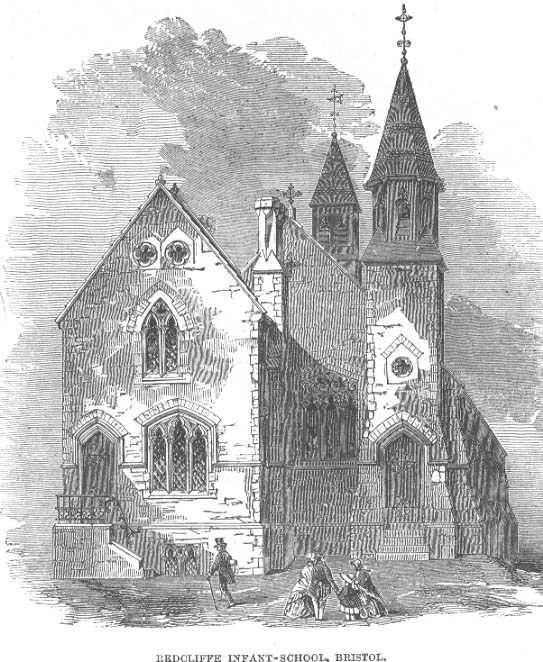
Source: The Illustrated London News, April 30, 1853

Every addition to our scholastic institutions is at this moment peculiarly interesting, from the large share of public attention directed to the subject of the Education of the People. The instance before us has a twofold attraction; in its presenting a welcome termination to protracted Chancery proceedings; and a successful application of the funds thus set free, in carrying out the intentions of the benevolent founder; this being, we understand, the cheapest building ever erected in Bristol.
The city of Bristol—which in wealth, trade, and population was long reckoned next to London within this kingdom, is famed for the number and effiency of its endowed charities. Among its benefactors we find recorded a worthy citizen named Brickdale, who, many years ago, willed that the proceeds of certain lands which he possessed should be applied to benevolent purposes. But these good intentions were for a time frustrated. A doubt arose in the mind of a certain churchwarden, whether the particular course which had been given to the charity was that which Brickdale had desired; a "friendly suit" in Chancery was instituted, and the funds were locked up, save for expenditure in costs. The details are not requisite for our present purpose; suffice it to say that an order to obtain a site and erect a School for Infants, was confirmed in 1845; and by those steps, slow if not sure, for which the Court is noted, matters have been brought so near to a close, that a School and Residence have been erected on the south side of Pile-street, not far from Radcliffe's Church, from the designs and under the superintendence of Mr. George Godwin, F.R.S. and F.S.A.
We engrave an elevation of the structure, which is a meritorious architectural composition, and well-arranged plan. It includes a schoolroom, fifty feet long by twenty-five feet wide, with a gallery for assembling the children, fifteen feet by ten feet six inches; a residence for the mistress; and a covered play-ground beneath the school. The height of the schoolroom is twelve feet at the sides, and twenty-five feet in the centre. Ventilation is provided for by gratings at the level of the floor and under the plate, and by a louvre in the roof; while fresh warmed air is admitted from the back of the stove, which is formed of fire lumps. The building is of Pennant stone, with Bath stone dressings: the walls, internally, are rendered with blue lias cement. The roof is covered with green Bangor slates. The porch is surmounted by a turret for the bell. The tenders for the work ranged from £1066 to £789; the cost of the whole has been about £800. The School is built almost within the patriarchal shade of St. Mary, Redcliffe, one of the finest specimens of parochial church architecture in England, in the restoration of which Mr. Godwin has for some time been engaged. The school was, we believe, used for the first time on Saturday last. The architect, we perceive, is a candidate for the Islington district surveyorship, now vacant: Mr. Godwin has worked many years for the public (without fee or desire for it), both in sanitary progress and in the honorary secretaryship of the Art-Union of London; which labours will, doubtless, be appreciated in the coming contest.
External site: St. Mary Redcliffe